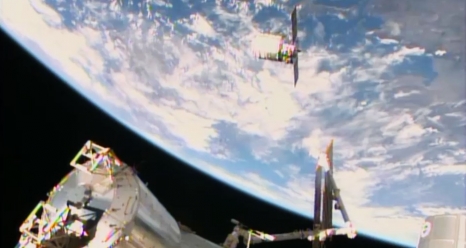Cygnus Begins Station Stay
In case you missed it, here is yesterday’s press release from Orbital Sciences announcing the early morning capture and berthing of the second Cygnus cargo vessel to ISS.
ORBITAL’S CYGNUS SPACECRAFT SUCCESSFULLY BERTHS WITH INTERNATIONAL SPACE
STATION
— Rendezvous and Berthing Operations of Company’s First Operational Cargo
Logistics Mission Proceeded Smoothly —
— Cargo Unloading to Begin Tomorrow with 37-Day Stay at Station Planned —
(Dulles, VA 12 January 2014) – Orbital Sciences Corporation (NYSE: ORB),
one of the world’s leading space technology companies, today announced that
its Cygnus™ cargo logistics spacecraft successfully completed its
rendezvous and approach maneuvers with the International Space Station
(ISS) and was grappled and berthed with the station by the Expedition 38
astronaut crew earlier this morning. After Cygnus was launched into orbit
by Orbital’s Antares™ rocket on Thursday, January 9 from NASA’s Wallops
Flight Facility, it completed a series of thruster firings and other
maneuvers bringing the spacecraft in close proximity to the ISS. Final
approach to the station began at about 3:00 a.m. (EST) this morning,
culminating with the station’s robotic arm grappling the spacecraft at 6:08
a.m. when it was about 30 feet (10 meters) from the ISS. Cygnus was then
guided to its berthing port on the nadir side of the ISS’ Harmony module
where its installation was completed at 8:05 a.m.
“Our first mission under the CRS contract with NASA was flawlessly executed
by our Antares and Cygnus operations team, from the picture-perfect launch
from NASA’s Wallops Flight Facility to the rendezvous, capture and berthingat the space station this morning,” said Mr. David W. Thompson, Orbital’s
President and Chief Executive Officer. “From the men and women involved in
the design, integration and test, to those who launched the Antares and
operated the Cygnus, our whole team has performed at a very high level for
our NASA customer and I am very proud of their extraordinary efforts.”
Cygnus will remain berthed at the ISS until February 18. Cygnus is
delivering approximately 2,780 lbs. (1,260 kg.) of cargo and science
payloads to the Expedition 38 astronauts. Either later today or tomorrow,
the crew plans to open the Cygnus hatch and make initial ingress into its
cargo module. Cygnus will remain attached to the station for 37 days
before departing with approximately 2,800 lbs. (1,300 kg.) of disposable
cargo for a safe, destructive reentry over the Pacific Ocean.
Under a $1.9 billion CRS contract with NASA, Orbital will use Antares and
Cygnus to deliver up to 44,000 pounds (20,000 kilograms) of cargo to the
ISS over eight missions, including the mission currently underway, through
late 2016. For these missions, NASA will manifest a variety of essential
items based on ISS program needs, including food, clothing, crew supplies,
spare parts and equipment, and scientific experiments.
About Cygnus
Orbital developed the Cygnus cargo spacecraft as part of its COTS joint
research and development initiative with NASA. Cygnus consists of a common
Service Module (SM) and a Pressurized Cargo Module (PCM). The SM
incorporates avionics, power, propulsion and communications systems already
successfully flown aboard dozens of Orbital’s LEOStar™ and GEOStar™
satellites. The PCM, designed and built by Thales Alenia Space under a
subcontract from Orbital, is based on the Multi-Purpose Logistics Module
(MPLM) previously used with the Space Shuttle. With a full load of cargo
and fuel, the standard-configuration Cygnus weighs about 5,200 kg at launch and generates 3.5 kw of electrical power while in orbit. It is capable of
extended-duration missions of a year or longer in space.


